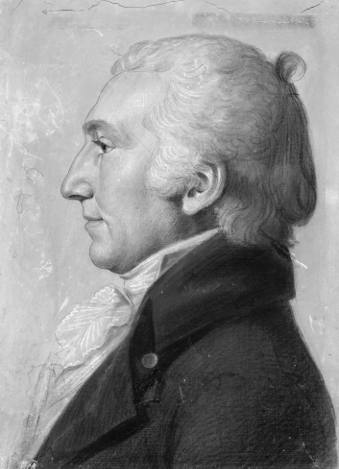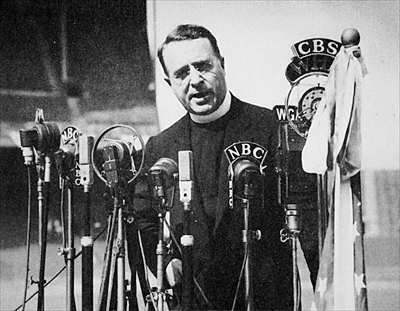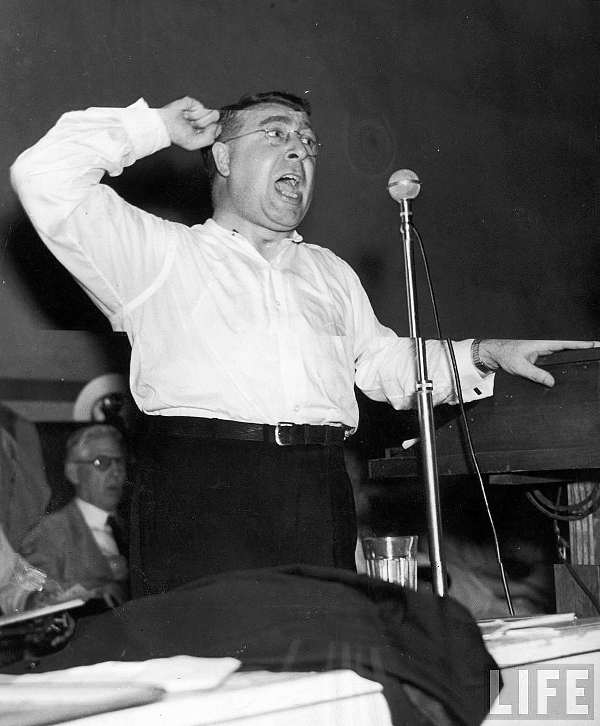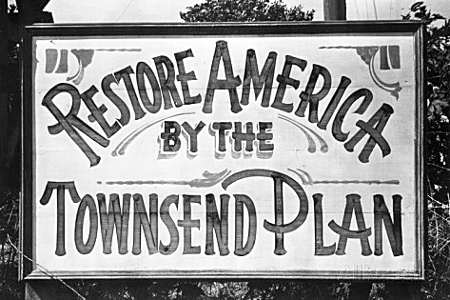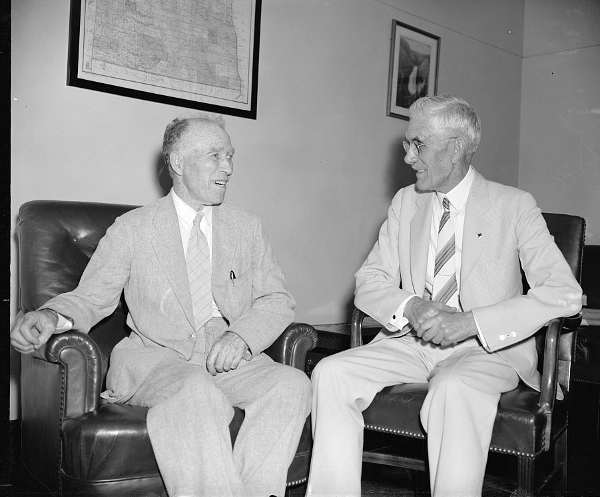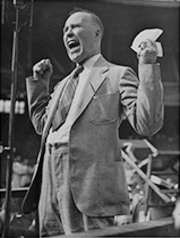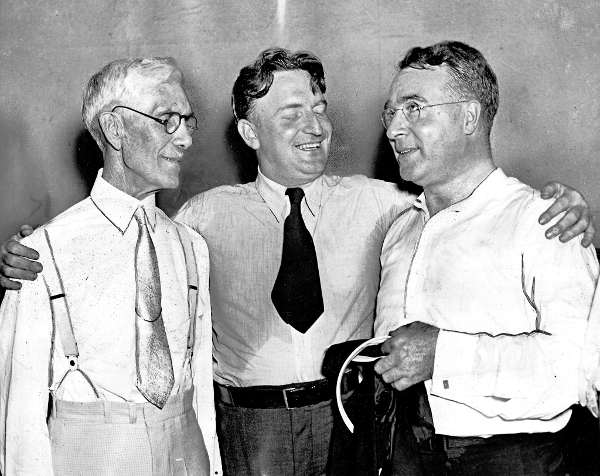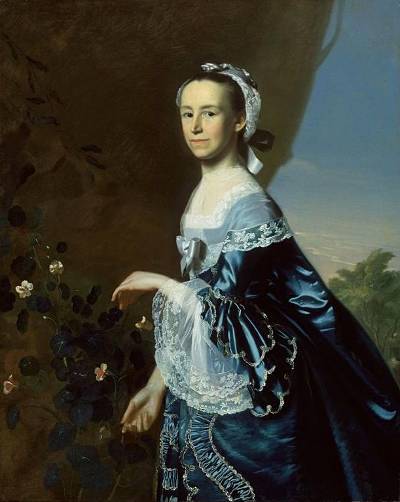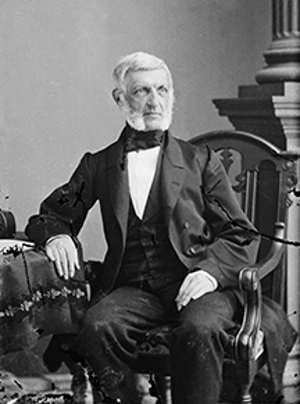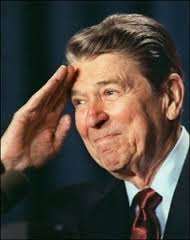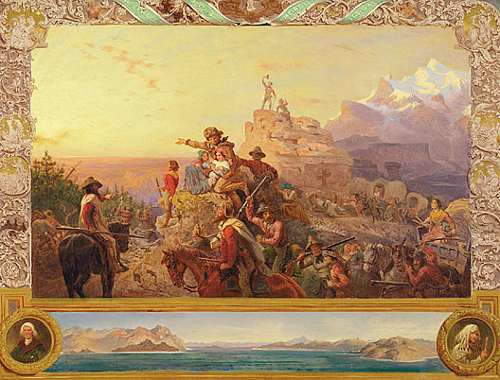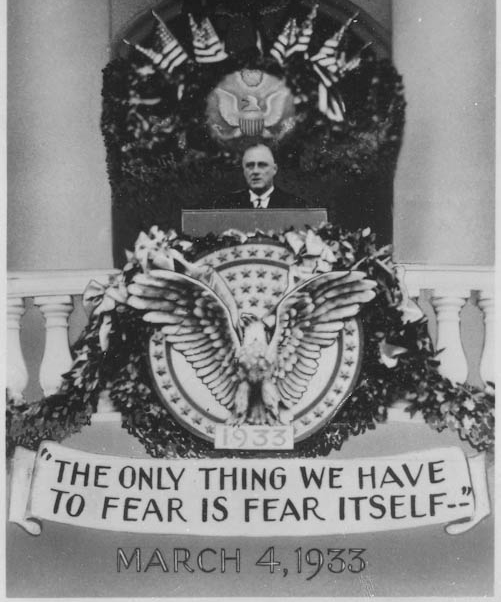
Photo Credit: Hackernoon
“I’m a student of history and I see what happens when you fire people and it’s not good.”
Donald Trump, remarks, April 26, 2019
Perhaps we are so inured to President Trump’s declarations of “fake news” that we don’t think much about his other methods of disinformation—history, for example—unless, of course, it is to chuckle at his apparent ignorance of the past when he makes a gaffe. But Trump is thinking more about history than we imagine and he is doing so in a way very different from former presidents, who used history as a way to unite the nation. For Trump history is a way to enhance his personal power. Occasionally Trump’s apparent ignorance of history makes headlines, and when it does we tend to dismiss it as not very serious in comparison with other presidential failings. But we should not be complacent. It is a powerful part of his political armamentarium aimed at our democracy.
TRUMP’S FAKE PAST
Shortly after his inauguration, President Trump moved a portrait of Andrew Jackson into the Oval Office. We soon learned that under the tutelage of chief strategist Steve Bannon, the president had become an admirer of Andrew Jackson—ironically enough the founder of the Democratic Party. But it wasn’t Jackson’s party affiliation that attracted the new president; it was his populism and strong man anti-establishment politics, qualities that Trump sees in himself.
The president’s apparently slender grasp of history grabbed headlines on May 1, 2017, when he gave an interview on satellite radio, telling the Washington Examiner’s Salena Zito, that “had Andrew Jackson been a little bit later you wouldn’t have had the Civil War. He was a very tough person, but he had a big heart. He was really angry that he saw what was happening with regard to the Civil War, he said, ‘There’s no reason for this.’”
Of course Andrew Jackson died in 1845, sixteen years before the Civil War broke out. Trump may have been referring to the nullification crisis of 1832, a standoff between the federal government and South Carolina. But the facts of history have little relevance when Trump is making a point. The point was that in Trump’s view a powerful leader who breaks the rules can save the country, even from a calamity as “irrepressible” (to quote William H. Seward) as the Civil War.
The Jackson portrait controversially formed the backdrop for an event honoring World War II Navajo code talkers later in 2017, when the president created a spectacle by posing the Native American veterans in front of the Jackson portrait. Could it have been accidental—or simply boorish—that he drew attention to Andrew Jackson’s infamous 1830 Indian Removal Policy, the forced relocation of Native Americans from their homelands in the southeastern United States to “Indian Territory” west of the Mississippi River in today’s Oklahoma? Are there echoes here of his white nativism and anti-immigrant policies? Politicizing the event further, Trump took the occasion to renew his attack on Senator Elizabeth Warren with the insulting nickname “Pocahantas.”

President Trump at event honoring Navaho Code Talkers, November 27, 2019 Credit: AP
Trump is famously proud of what he sees as his intelligence, which often leads him to depart from prepared remarks. When he extemporizes about history, he betrays his abysmal ignorance—but it is worth remembering that such comments have their origins in a vainglorious desire to impress, not an innocuous ignorance. During Black History Month in 2017, Trump seemed to think Frederick Douglass is still alive. “I am very proud now that we have a museum on the National Mall where people can learn about Reverend King, so many other things, Frederick Douglass is an example of somebody who’s done an amazing job and is getting recognized more and more, I notice.” There were other times when his basic ignorance of history raised eyebrows: he inquired from the podium at a National Republican Congressional Committee fundraising dinner if anyone knew Abraham Lincoln was a Republican. “Great president. Most people don’t even know he was a Republican.” Or when he spoke to the Women’s Empowerment Panel and asked his audience, “Have you heard of Susan B. Anthony?”
He was rightly ridiculed for these remarks. But as New York Times columnist Roger Cohen has said, “History is no joke. It’s on the curriculum because it is only through it that the psyches of other nations can be understood and wars averted.” I would add that it is only through an understanding of American history that we can transmit the principles of our democracy to the next generation.
THE END OF HISTORY?
The title for this piece is borrowed from Francis Fukuyama’s famous 1989 essay published in The National Interest. Fukuyama declared that with the fall of the Berlin Wall the world was about to experience the “end of history.”
“What we may be witnessing is not just the end of the Cold War,” he wrote, “or the passing of a particular period of postwar history, but the end of history as such.” For Fukuyama writing in an age of hope for a new “post-ideological” world—that is, a world not driven by communism, fascism, or even monarchism and imperialism—it seemed that we had achieved a level of human political development marked by the triumph of liberal democracy in partnership with modern capitalism. He saw “the universalization of Western liberal democracy as the final form of human government.”
Fukuyama has been much criticized for his seemingly premature (if not naive) declaration of the triumph of liberal democracy, especially as the events of the past decade unfolded: the disastrous outcome of the Arab Spring’s promise of democracy; the rise of autocrats in Hungary, Turkey, Thailand, and Poland—not to mention China and Russia; and now the increasingly illiberal politics of nativist and anti-immigrant parties in France, Germany, Austria, and the Netherlands. Britain struggles to define itself in the wake of Brexit . . . and in the United States the Trump administration has made common cause with dictators around the world and breathed new life into nativism, white nationalism, and isolationism.
We may, in fact, be witnessing the end of liberal democracy instead of the end of history. And closing our minds to the objective past can only hasten the process.
TRUMP ERASES HISTORY
In an impromptu press conference on the White House lawn before heading to a National Rifle Association event in Indiana, Trump reprised his notorious statement that there were “very fine people” on “both sides” of the August 12, 2017, riot in Charlottesville, Virginia. His comments were prompted by Joe Biden’s criticism of Trump’s response to Charlottesville as the centerpiece of his announcement of his presidential candidacy against Trump. In response, Trump pronounced that he had handled the incident “perfectly.” Denying that he was referring to white supremacists when he equated the opposing sides of the demonstrations that led to the riot, Trump insisted he was “talking about people that went because they felt very strongly about the monument to Robert E. Lee, a great general.” He continued, “People were there protesting the taking down of the monument of Robert E. Lee. Everybody knows that.”
The history of Charlottesville’s Robert E. Lee sculpture controversy bears review. Its origins lie in the 2015 mass shooting in which nine African-American worshippers were murdered at a black church in Charleston, South Carolina, by a neo-Confederate white supremacist seeking to incite a race war. In the wake of that shooting, Confederate monuments and symbols were removed nationwide. In Charlottesville local citizens petitioned the city council for the removal of the statue of Robert E. Lee and other symbols. To decide the question, the city council appointed a Blue Ribbon Commission on Race, Memorials, and Public Spaces—which recommended removal, an action approved by the city council in February 2017. Opponents of removal, including the Sons of Confederate Veterans, filed a lawsuit against the city. By then the fate of the statue was the subject of intense local controversy. In May a notorious local white nationalist, Richard B. Spencer, led a torchlight parade protesting the removal of the statue; in July fifty Ku Klux Klan members held a rally to protest removing the statue, which attracted several hundred counter-protestors. Both events were dispersed by police, who used tear gas and made 23 arrests at the July rally.

Unite the Right demonstrators in Charlottesville, Virginia.
Image courtesy of Unicorn Riot via Wikipedia Commons
A larger gathering of white supremacists from several states, dubbed the Unite the Right rally, was called for August 11–12. Protesters included neo-Confederates, neo-fascists, white nationalists, neo-Nazis, the KKK, and far right militia members. They chanted racist and anti-Semitic slogans and displayed neo-Confederate, neo-Nazi, and anti-Muslim regalia as they marched carrying lighted torches. They were met by counter-protestors, one of whom was killed and nineteen of whom were injured when a white nationalist plowed his car into the crowd of counter-protestors.
This nuanced and highly sensitive history is completely erased by Trump’s simplistic explanation of his comment that he was referring to nothing more complicated than protests and counter-protests over the statue of a “great general.” Given the circumstances of the events surrounding Charlottesville, it is hard to avoid the conclusion that Trump is deliberately distorting these events. Is he trying to solidify his electoral base by changing the facts to suit his purposes? And do those purposes include glossing over America’s troubled history of race relations?
In addition to simplification, repetition is an important part of Trump’s political strategy in using history. A series of extracts from the Washington Post’s Fact Checker.com makes this clear. For example, on January 19, 2019, he declared:
Newt Gingrich just stated that there has been no president since Abraham Lincoln who has been treated worse or more unfairly by the media than your favorite President, me! At the same time there has been no president who has accomplished more in his first two years in office!
This statement was repeated 57 times. In rebuttal, Fact Checker states in part, “Trump, unlike many presidents in his first two years, had signed few major pieces of legislation. Certainly, the whirlwind of accomplishments under presidents such as Franklin D. Roosevelt, Lyndon B. Johnson, Ronald Reagan and Barack Obama exceed Trump’s efforts.”
Or there was this statement on February 12, 2019: “More people working today in the United States than at any time in the history of our country.” This claim was repeated 55 times and was rebutted in part by Fact Checker with these words:
Of course there are more Americans working. That’s because there are more Americans today than ever before. More meaningful measures of the overall health of the job market take population into consideration. The unemployment rate, or the share of people who don’t have jobs, was at 3.9 percent in December and that wasn’t a record low.
Or on February 21, 2019, the president proclaimed “the largest tax cuts in the history of our country” and repeated it 131 times. Fact Checker responded:
Trump’s tax cut amounts to nearly 0.9 percent of the gross domestic product, meaning it is far smaller than President Ronald Reagan’s tax cut in 1981, which was 2.89 percent of GDP. Trump’s tax cut is the eighth largest tax cut—and even smaller than two tax cuts passed under Barack Obama.
Trump also declared, on April 15, “Our country has one of the best economies in many years, perhaps ever” and repeated it 134 times, but as the Fact Checker pointed out:
The president can certainly brag about the state of the economy, but he runs into trouble when he makes a play for the history books. By just about any important measure, the economy today is not doing as well as it did under Presidents Dwight D. Eisenhower, Lyndon B. Johnson or Bill Clinton—or Ulysses S. Grant.
These distortions of the historical record are just a few excerpts from the first few months of 2019. Psychologists tell us that repeating an untruth has the effect of validating it as truthful. This is called the “illusory truth effect” and is used often in advertising, political campaigns, and propaganda. Researchers first identified it in 1977 but its practitioners date back to Quintillian, Napoleon, and Marcus Antonio in Shakespeare’s Julius Caesar. President Trump understands the truth effect and uses it artfully as part of his disinformation attack on American history.
PRESIDENTIAL USES OF HISTORY
Politicians, of course, have always used history—and continue to do so today—to bolster their programs and policies. Some distort it to serve their purposes. Franklin Roosevelt spoke about how politicians use history to validate their positions at a Jackson Day dinner, January 8, 1940.
Millions of unnecessary words and explanations and solemn comments are uttered and written year in and year out about the great men of American history . . . to prove what Jefferson or Hamilton, Jackson or Clay, Lincoln or Douglas, Cleveland or Blaine, Theodore Roosevelt or Bryan, would have said or would have done . . . if they were alive today. . . . Yes, the devil can quote past statesmen as readily as he can quote the Scriptures, in order to prove his purpose.”
And yes, FDR massaged history to meet his political objectives . . . but I think there is much to be said about a president who communicates with the public secure in the knowledge that he and they share an understanding of a generally accepted “truthful” understanding of the American past.
According to Alexander Heffner, host of PBS’s Open Mind, Trump’s acceptance speech before the Republican National Convention on July 21, 2016—unlike the acceptance speeches of previous nominees—failed to mention a single presidential precedent. Beginning with Abraham Lincoln’s famous Cooper Union speech on February 27, 1860, in which Lincoln showed that a majority of the signers of the Constitution opposed extending slavery into new territories, presidential candidates have bolstered their positions to the electorate with historical allusions. Lincoln was able to demonstrate that his position, and that of the new Republican Party, was hardly radical; it was the view of the majority of the Founders. Other Republican presidents have similarly borrowed from their forbears. When Theodore Roosevelt broke away from the Republican Party to start the Bull Moose Party, he cited Lincoln. On the eve of America’s entry into World War II, Wendell Willkie—in his 1940 bid against Franklin Roosevelt—embraced TR’s motto “Walk softly and carry a big stick.” Ronald Reagan famously evoked the Puritans’ “shining city on a hill” to inspire his vision for a new America.

President Obama delivering his Second Inaugural Address, January 20, 2013.
Credit: USA Magazine
Yes, we are in a “post-historical” era in which the traditional narrative of American history is much contested. But the fundamentals of the American creed of liberty and equality remain potent—as Barack Obama made clear in his Second Inaugural, which was anchored in the Declaration of Independence. He called upon Americans to remember the Revolutionary War, Lincoln, the Civil War, and John F. Kennedy’s 1961 inaugural. He referenced Dr. Martin Luther King, Jr., and the nation’s struggle for civil rights including Seneca Falls, Selma, and Stonewall.
As Obama and every successful president before him has demonstrated, the power to lead this nation is connected to the power to inspire people to act upon the generative ideas of American democracy. When the president and the American public share an understanding of American history, they are in communication with one another and engaged in an exchange of ideas that can result in persuasion, changed minds, leadership, and a stronger and more equitable democracy.
Donald Trump’s uses of history are qualitatively different from those of other presidents. Unaware of or uninterested in the complexities of the past, history is useful to him only out of necessity when faced with the requirement to preside at an event with historical resonance (i.e., comments on Black History Month or before a group of feminist women), or when he finds himself in trouble for making insensitive comments (Charlottesville). These uses are, perhaps, easily dismissed by informed Americans for their obvious inaccuracy. But Trump also routinely turns to history to employ the “truth effect” on the record of his presidency. In broad, erroneous, and self-serving generalizations, he delivers a steady stream of disinformation: Trump has produced the best or the most successful economy or employment record, or the largest inaugural audience, or the most legislation and the most successful first hundred days of any president in American history. He bends and twists history to deliver a fake past that glorifies him and inflates his power. Americans who have an understanding of the nation’s past dismiss these conceits—but for many his “fake past,” like his pronouncements on “fake news,” take on the illusion of truth.
FDR’S USES OF HISTORY
Franklin Roosevelt often led by using historical example. Sometimes he made light of it, as in his Second Fireside Chat when he used America’s most famous self-made man to criticize Wall Street speculators who chafed under the New Deal’s banking and investment regulations. “Only a very small minority of the people of this country,” he declared, “believe in gambling as a substitute for the old philosophy of Benjamin Franklin that the way to wealth is through work.” Then he cheekily pointed out that government regulation was even favored by America’s first Republican president. “I believe with Abraham Lincoln, that ‘the legitimate object of Government is to do for a community of people whatever they need to have done but cannot do at all or cannot do so well for themselves.’”

Franklin D. Roosevelt Courtesy Franklin D. Roosevelt Library
But if reference to the “great men” of American history does not resonate today, FDR also called upon the common narrative of American resourcefulness in a speech commemorating George Rogers Clark.
I have called those of us who are here today ‘pioneers of 1934.’ . . . We, too, . . . have come to a realization . . . that the accustomed order of our formerly established lives does not suffice to meet the perils and the problems, which today we are compelled to face. Again, mere survival calls for a new pioneering on our part.
In the midst of World War II, FDR used Washington’s Birthday as the opportunity to call the nation together, recalling Washington’s famous prayer at Valley Forge.
The skeptics and the cynics of Washington’s day did not believe that ordinary men and women have the capacity for freedom and self-government. They said that liberty and equality were idle dreams that could not come true—just as today there are many Americans who sneer at the determination to attain freedom from want and freedom from fear, on the ground that these are ideals which can never be realized. They say it is ordained that we must always have poverty, and that we must always have war.
Here and in many other speeches FDR linked the achievement of lasting world peace to his two new freedoms (freedom from want and freedom from fear) and the fundamental guarantees of the First Amendment, freedom of speech and freedom of religion. Much as Obama linked the Declaration of Independence to civil rights, women’s rights, and the rights of the LGBT community, FDR—like any president seeking to strengthen the nation and the world—knew he could turn to history to support his case.
ON HISTORY AND AMERICAN LEADERSHIP

During their historic visit to the U.S. in 1939, the King and Queen of England visited Mount Vernon. Here they are pictured a few days later in front of the Roosevelt home in Hyde Park, June 8, 1939. From left: Eleanor Roosevelt, King George VI, Sara Delano Roosevelt, Queen Elizabeth, and Franklin Roosevelt. Credit: Legacy Files WordPress
In a telephone call to Mount Vernon I learned that Franklin Roosevelt visited Mount Vernon twelve times during his presidency, the most visits by any president before or since—most famously, perhaps, when he escorted the King and Queen of England to Washington’s home during their 1939 state visit. It was the first time that a reigning British monarch had set foot on American soil. With that visit FDR signaled the metaphorical end of the American Revolution and the beginning of the Anglo-American alliance that would be needed to defeat Hitler.
It was recently reported that President and Mrs. Trump escorted President and Madame Macron on a visit to Mount Vernon in April 2018. The museum’s president and CEO, Doug Bradburn, conducted the tour but found it hard to hold President Trump’s attention. So he explained that Washington was a major real estate speculator in his time.
Trump couldn’t understand why America’s first president didn’t name his historic Virginia compound or any of the other property he acquired after himself. “If he was smart, he would’ve put his name on it,” Trump said, according to three sources briefed on the exchange. “You’ve got to put your name on stuff or no one remembers you.”
Bradburn then told the president that Washington did, after all, succeed in getting the nation’s capital named after him. Good point, Trump said with a laugh.

President and Mrs. Trump and President and Madame Macron at Mount Vernon,
April 23, 2018. Image courtesy of Mount Vernon Ladies Association
But did Trump really get the point?
That Washington’s greatness was founded in his modesty, truthfulness, and above all his understanding that presidential power in a democratic republic requires the ability to turn away from it.
That Washington could have been king, or at the very least president for life. Everyone wanted him to remain in power but he returned to Mount Vernon.
That Washington knew he was establishing important precedents for every president to follow. Does Trump understand what every president before him has understood: the importance of historical precedent, not as useful for “cover,” self-promotion, or personal protection, but rather as fundamental to American governing?
Trump’s behavior suggests that he does not understand the basics of our form of government, all of which are grounded in history.
- The separation of powers and the necessity for the executive to share power with Congress and the courts.
- The importance of freedom of the press, freedom of expression, and freedom of religion.
- The importance of honoring and extending national values—among them, the U.S. as a haven for the world’s dispossessed.
- An awareness of the accomplishments of past generations.
- The need to continue the unfinished work of the promise of liberty and justice for all.
- The importance of understanding the sources of U.S. power in its alliances, upholding its treaties, and in international institutions such as NATO and the UN.
- And above all America’s role in the world as the exemplar of liberal democracy.
Arthur Schlesinger, Jr., writing on the eve of the millennium, was as confident as Fukuyama that we had achieved an historic triumph over the political ideologies of the past.
Our world at the millennium is plainly not Hitler’s world.
The Thousand Year Reich had a ghastly run of a dozen years.
Nor is it the world of Lenin and Stalin.
The Communist dream turned out to be a political, economic, and moral nightmare.
Nor is it Churchill’s world. He was a great war leader, but he was the son of empire, and empires have faded into oblivion.
Our world today is Roosevelt’s world.
For liberal democracy to survive, let alone to thrive as Schlesinger and Fukuyama saw it, the president must understand history and his place in it. And then he (or she) has to use it to lead all the people to a shared understanding of the meaning of American democracy.
In Trump I’m afraid we have literally come face to face with the end of historical understanding, which opens the door to that which our founders most feared—the abuse of power. In the 18th century the danger was the unbridled monarchy; today it is the autocrat, the demagogue. Let us reconfirm our national commitment to historical understanding as a vital force in animating American citizenship and democracy.

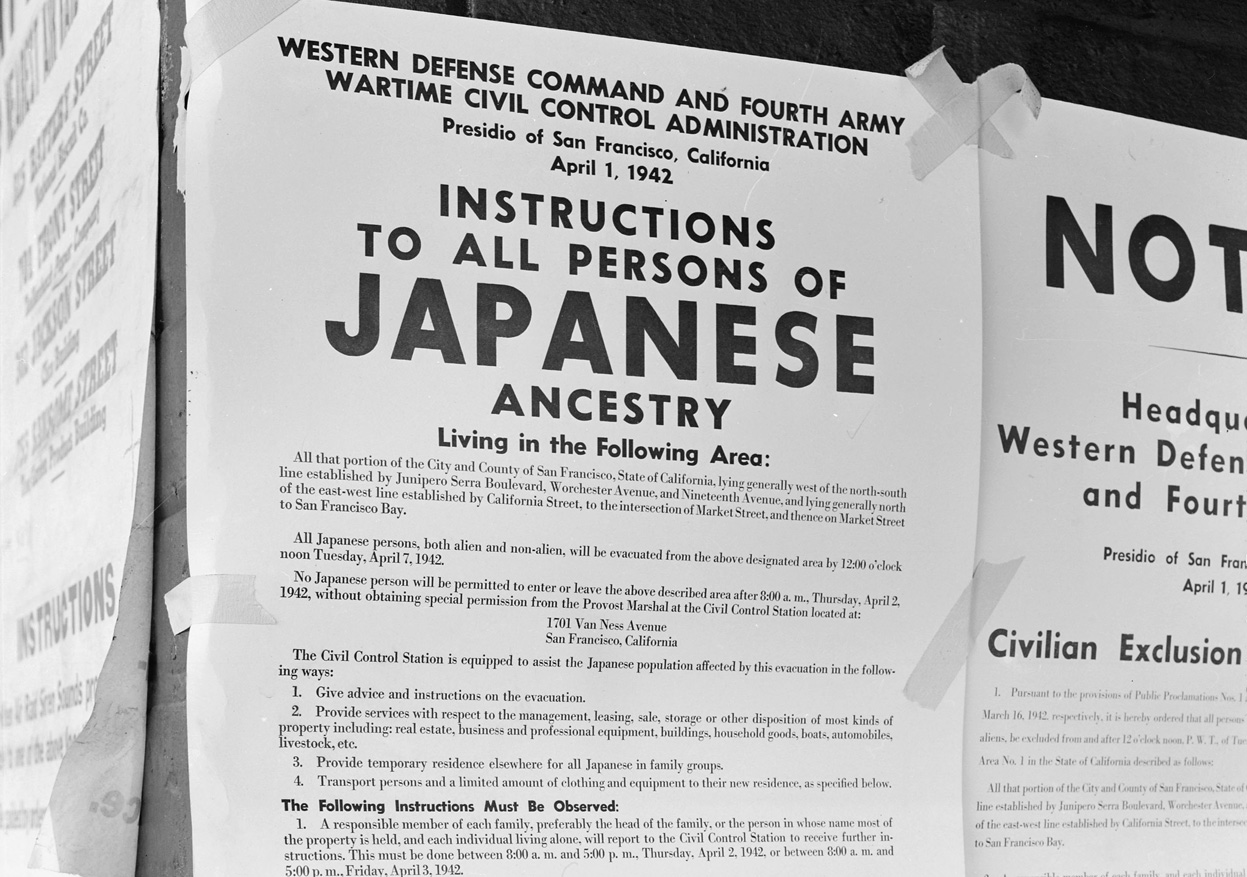
 How did these ideas affect the young FDR? He deplored visceral prejudice, and he expressed interest in Japanese culture and became friendly with a number of Japanese. Nevertheless, he regarded the Japanese as a danger. In 1913, shortly after Roosevelt was named Assistant Secretary of the Navy in the government of Woodrow Wilson, the protests of California whites against Japanese immigrant farmers led to the Alien Land Act, as I mentioned, which forbade these immigrants property rights. The passage of the law set off vigorous protests within Japan, and when an extreme nationalist called for a blockade of America in return, Roosevelt had drawn up a plan for naval war between Japan and the United States and recommended the massing of the Pacific fleet in preparation for such a war. Although the immediate crisis abated following some careful diplomacy, in the years that followed, even as the United States moved closer to involvement in World War I, he continued to call for the arming of the Pacific fleet for war against Japan, which he considered the most dangerous foreign threat. The greatest lesson he took from the incident was that Japanese Americans were a source of trouble—friction with their neighbors and aggression by Japan.
How did these ideas affect the young FDR? He deplored visceral prejudice, and he expressed interest in Japanese culture and became friendly with a number of Japanese. Nevertheless, he regarded the Japanese as a danger. In 1913, shortly after Roosevelt was named Assistant Secretary of the Navy in the government of Woodrow Wilson, the protests of California whites against Japanese immigrant farmers led to the Alien Land Act, as I mentioned, which forbade these immigrants property rights. The passage of the law set off vigorous protests within Japan, and when an extreme nationalist called for a blockade of America in return, Roosevelt had drawn up a plan for naval war between Japan and the United States and recommended the massing of the Pacific fleet in preparation for such a war. Although the immediate crisis abated following some careful diplomacy, in the years that followed, even as the United States moved closer to involvement in World War I, he continued to call for the arming of the Pacific fleet for war against Japan, which he considered the most dangerous foreign threat. The greatest lesson he took from the incident was that Japanese Americans were a source of trouble—friction with their neighbors and aggression by Japan.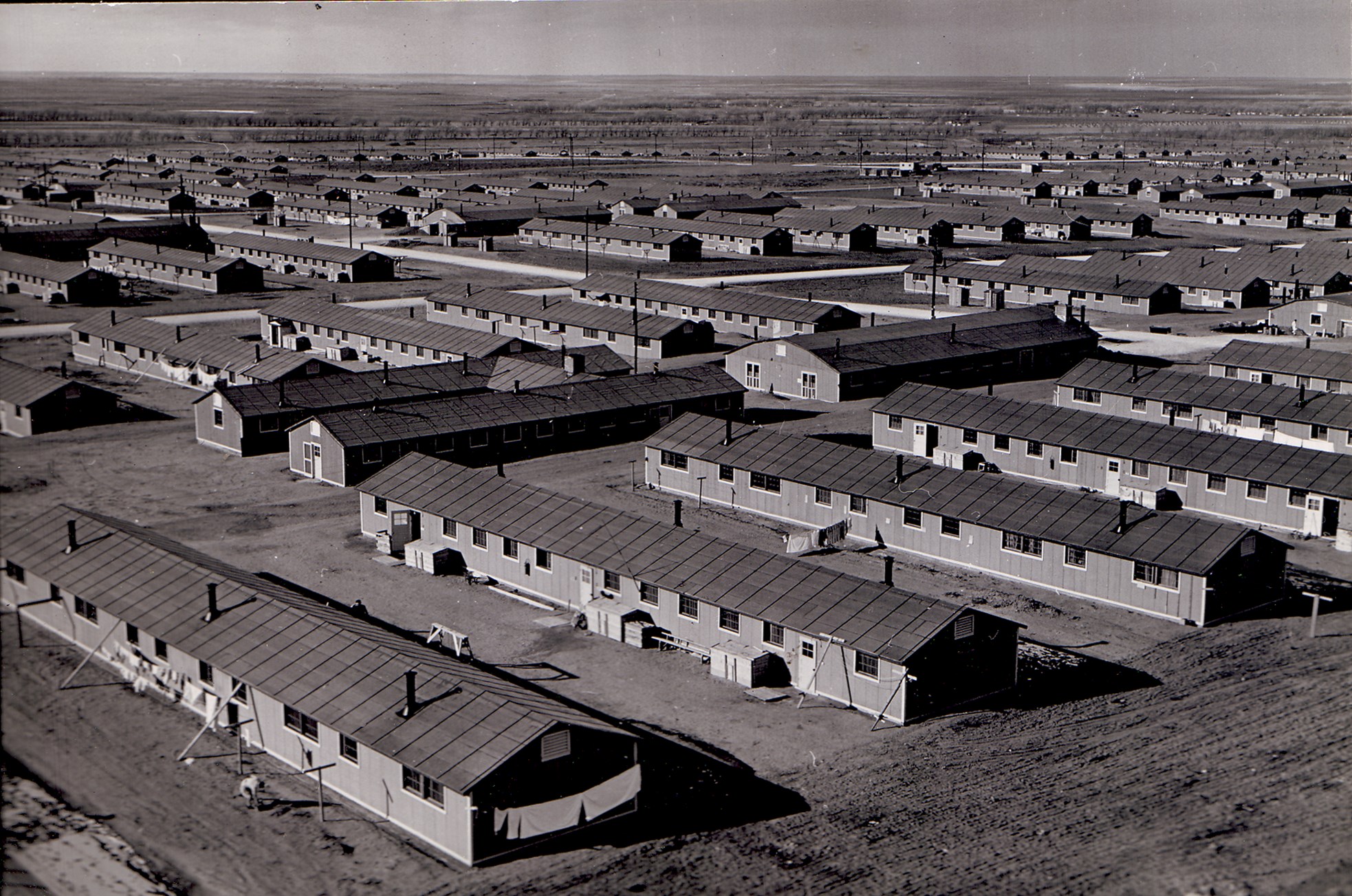 Roosevelt was sure that if the United States defended exclusion on a purely racial basis, the Japanese would not protest and relations between the two countries would remain harmonious. After all, he said, the Japanese were known to have strong taboos against interracial marriage, and would not want to have their national culture polluted by such inter-mixtures:
Roosevelt was sure that if the United States defended exclusion on a purely racial basis, the Japanese would not protest and relations between the two countries would remain harmonious. After all, he said, the Japanese were known to have strong taboos against interracial marriage, and would not want to have their national culture polluted by such inter-mixtures: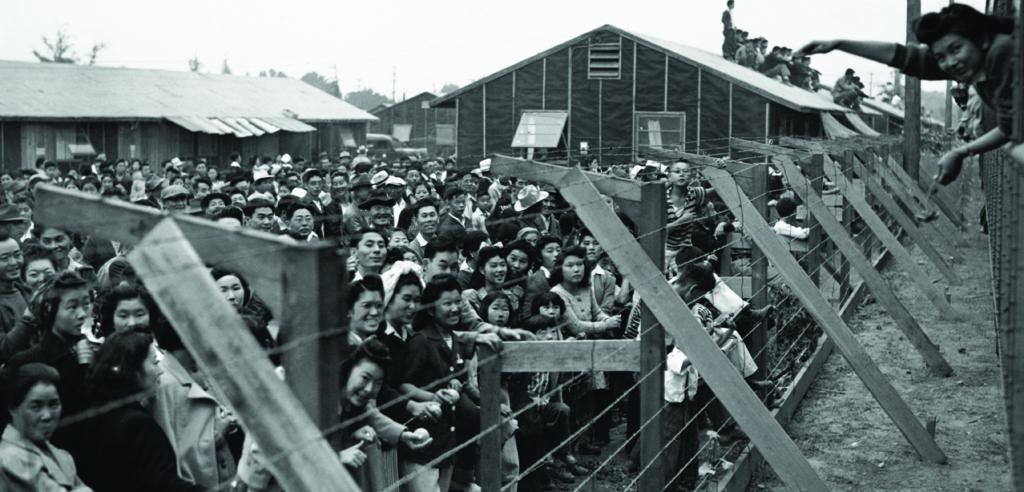 Roosevelt’s basic attitude towards Japanese Americans may have also shaped his response to the moral and constitutional questions involved in mass evacuation. FDR’s refusal to admit the discriminatory purpose behind race-based exclusion of Japanese immigrants during the 1920s and his contention that Californians rightly objected to the Japanese presence in their midst also serves as a model for his voluntary blindness to the essential role of racial hostility and economic jealousy in motivating calls for mass removal of Japanese Americans by Californians with a long history of nativist bias. Moreover, during his 1920s articles, Roosevelt defended the denial of property rights to Japanese immigrants as a way to ensure racial purity. This attitude could well have contributed to Roosevelt’s unwillingness to stake steps to protect the property of the evacuees such the appointment of a strong Alien Property Custodian, with the result that the interned Japanese Americans were forced to sell off their property at ridiculously low prices or were stripped of it by the white “friends” to whom they entrusted it, or were forced to place it in unguarded warehouses which were looted and vandalized.
Roosevelt’s basic attitude towards Japanese Americans may have also shaped his response to the moral and constitutional questions involved in mass evacuation. FDR’s refusal to admit the discriminatory purpose behind race-based exclusion of Japanese immigrants during the 1920s and his contention that Californians rightly objected to the Japanese presence in their midst also serves as a model for his voluntary blindness to the essential role of racial hostility and economic jealousy in motivating calls for mass removal of Japanese Americans by Californians with a long history of nativist bias. Moreover, during his 1920s articles, Roosevelt defended the denial of property rights to Japanese immigrants as a way to ensure racial purity. This attitude could well have contributed to Roosevelt’s unwillingness to stake steps to protect the property of the evacuees such the appointment of a strong Alien Property Custodian, with the result that the interned Japanese Americans were forced to sell off their property at ridiculously low prices or were stripped of it by the white “friends” to whom they entrusted it, or were forced to place it in unguarded warehouses which were looted and vandalized.